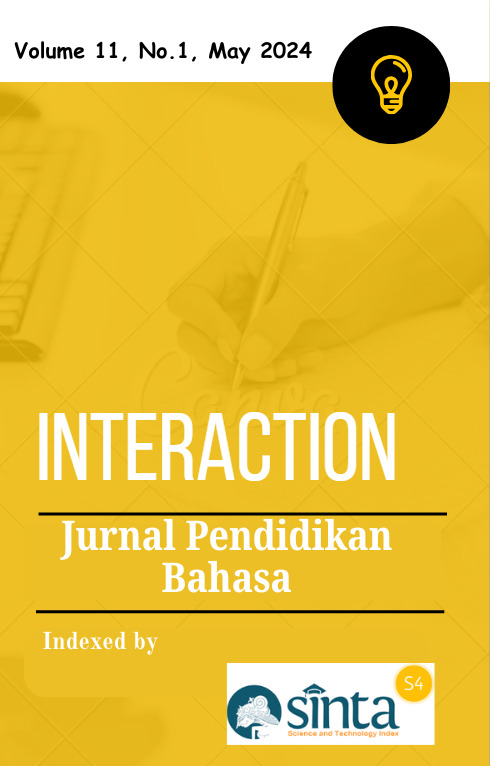Investigating Students' Perceptions of Digital vs. Print Reading Materials
Abstract
In this study, students' perceptions regarding their preference for digital or printed reading materials were analyzed using a quantitative approach. The research design employed was a survey with a descriptive design. This design aimed to collect opinions and preferences from students regarding their reading habits and experiences with both digital and print materials. A questionnaire was used to gather data from 103 students in grade 12 (science, social science, and language studies) at SMAN 10 Malang. The study showed that most students liked both printed and digital materials, but slightly preferred digital ones. They enjoyed reading digitally more than on paper because it was easier and convenient, though they felt equally comfortable with both. Students liked the appealing design of both, but digital content intrigued them more. They understood that both were important for learning English, but they favored digital materials for being up-to-date. However, they found it easier to take notes with printed materials. The study found that most students liked both digital and printed materials, but they slightly favored digital ones. The mean score for digital reading materials was 3.92, while for printed materials, it was 3.68. Overall, they did not find either format too difficult, finding digital materials quick to access but feeling neutral towards printed ones. Although students recognized the benefits of digital resources, their preference for learning from digital materials over print was neutral.
Downloads
References
Ambarwati, D., Syahri, I., & Sulaiman, M. (2021). STUDENTS’ PERCEPTIONS TOWARDS DIGITAL TEXT READING. Exposure: Jurnal Pendidikan Bahasa Inggris, 10(1), 430–447.
Bana, A. (2020). Students’ Perception of Using the Internet to Develop Reading Habits. JET (Journal of English Teaching), 6(1), 60–70. https://doi.org/10.33541/jet.v6i1.46
Farnsworth, M. (2014). Differences in Perceived Difficulty in Print and Online Patient Education Materials. The Permanente Journal, 18(4), 45–50. https://doi.org/10.7812/TPP/14-008
Foasberg, N. M. (2014). Student Reading Practices in Print and Electronic Media. College & Research Libraries, 75(5), 705–723. https://doi.org/10.5860/crl.75.5.705
Giebelhausen, R. (2016). The Paperless Music Classroom. General Music Today, 29(2), 45–49. https://doi.org/10.1177/1048371315608224
Ivić, I. (2019). Printed and Digital Media: Printed and Digital Textbooks. Center for Educational Policy Studies Journal, 9(3), 25–49. https://doi.org/10.26529/cepsj.694
Kharisma, A., Wulyani, A. N., & Astuti, U. P. (2021). STUDENTS’ PREFERENCE OF DIGITAL OR PRINT BOOKS/READING MATERIALS. NEELLS Proceeding National English Education, Language, and Literature Seminar.
Kong, Y., Seo, Y. S., & Zhai, L. (2018). Comparison of reading performance on screen and on paper: A meta-analysis. Computers and Education, 123, 138–149. https://doi.org/10.1016/j.compedu.2018.05.005
Lim, E.-L., & Hew, K. F. (2014). Students’ perceptions of the usefulness of an E-book with annotative and sharing capabilities as a tool for learning: a case study. Innovations in Education and Teaching International, 51(1), 34–45. https://doi.org/10.1080/14703297.2013.771969
Maharani, M., Gusnardi, G., & Gimin, G. (2023). The Influence Of Learning Media, Facilities, and Learning Interest on Students Motivation and Economic Learning Outcome At SMA Negeri District Tenayan Raya. Jurnal EDUCATIO: Jurnal Pendidikan Indonesia, 9(2), 912. https://doi.org/10.29210/1202323069
Manalu, B. H. (2019). Students’ Perception of Digital Texts Reading: A Case Study at the English Education Department of Universitas Kristen Indonesia. JET (Journal of English Teaching), 5(3), 191. https://doi.org/10.33541/jet.v5i3.1312
Mayembe, E., & Nsabata, S. (2020). Print-Based Learning Media. Journal Educational Verkenning, 1(1), 1–7. https://doi.org/10.48173/jev.v1i1.23
Ningsih, I. H., Winarni, R., & Roemintoyo, R. (2019). THE IMPORTANCE OF EARLY READING LEARNING IN THE FACE OF 21st CENTURY EDUCATION. AL-ASASIYYA: Journal Of Basic Education, 3(2), 196. https://doi.org/10.24269/ajbe.v3i2.1879
Nishanthi, R. (2020). Understanding of the Importance of Mother Tongue Learning. International Journal of Trend in Scientific Research and Development (IJTSRD) , 5(1), 77–80. https://www.researchgate.net/publication/345436020
Pardede, P. (2019). Print vs Digital Reading Comprehension in EFL: A Literature Review. JET (Journal of English Teaching), 5(2), 77. https://doi.org/10.33541/jet.v5i2.1059
Srirahayu, D. P., & Premananto, G. C. (2020). The Printed Book and Electronic Book (Ebook) Experiences of Digital Natives in Indonesia. Journal of Southwest Jiaotong University, 55(6). https://doi.org/10.35741/issn.0258-2724.55.6.17
Villegas, G. K. E., Badilles, B. M. C., Ocay, J. C., Sabanal, D. M. D., Arcamo, F. E. S., & Tantog, A. J. D. (2023). Describing Students’ Reading Efficiency in the Use of Printed and Digital Materials. In International Journal of Academic Multidisciplinary Research (Vol. 7). www.ijeais.org/ijamr
Welsen, S., Wanatowski, D., & Zhao, D. (2023). Behavior of Science and Engineering Students to Digital Reading: Educational Disruption and Beyond. Education Sciences, 13(5), 484. https://doi.org/10.3390/educsci13050484




.png)



22.png)
